If you follow the latest developments in modern gaming even casually, as I do, you know that Microsoft and Activision Blizzard recently concluded the most eye-watering transaction ever to take place in the industry: the former acquired the latter for a price higher than the gross national product of more than half of the world’s countries. I find it endlessly amusing to consider that Activision may have lived long enough to set that record only thanks to Infocom, that humble little maker of 1980s text adventures, whose annual revenues — revenues, mind you, not profits — never exceeded $10 million before Activision acquired it in 1986. And just how did this David save a Goliath? It happened like this:
After Bobby Kotick arranged a hostile takeover of a bankrupt and moribund Activision in 1991, he started rummaging through its archives, looking for something that could start bringing some money in quickly, in order to keep the creditors who were howling at his door at bay for a wee bit longer. He came upon the 35 text adventures which had been made by Infocom over the course of the previous decade, games which, for all that they were obviously archaic by the standards of the encroaching multimedia age, were still fondly remembered by many gamers as the very best of their breed. He decided to take a flier on them, throwing twenty of them onto one of those shiny new CD-ROMS that everyone was talking about — or, if that didn’t work for you, onto a pile of floppy disks that rattled around in the box like ice cubes in a pitcher of lemonade. Then he photocopied the feelies and hint books that had gone with the games, bound them all together into two thick booklets, and stuck those in the box as well. He called the finished collection, one of the first notable examples of “shovelware” in gaming, The Lost Treasures of Infocom.
It sold 100,000 or more units, at $60 or $70 a pop and with a profit margin to die for. The inevitable Lost Treasures II that followed, collecting most of the remaining games,[1]The CD-ROM version included fourteen games, missing only Leather Goddesses of Phobos, which Activision attempted to market separately on the theory that sex sells itself. The floppy version included eleven games, lacking additionally three of Infocom’s late illustrated text adventures. was somewhat less successful, but still more than justified the (minimal) effort that had gone into its curation. The two products’ combined earnings were indeed enough to give pause to those creditors who had been pushing for the bankrupt company to be liquidated rather than reorganized.
With a modicum of breathing room thus secured, Kotick scraped together every penny he could find for his Hail Mary pass, which was once again to rely upon Infocom’s legacy. William Volk, his multimedia guru in residence, oversaw the production of Return to Zork, a splashy graphical adventure with all the cutting-edge bells and whistles. In design terms, it was an awful game, riddled with nonsensical puzzles and sadistic dead ends. Yet that didn’t matter at all in the marketplace. Return to Zork rammed the zeitgeist perfectly by combining lingering nostalgia for Zork, Infocom’s best-selling series of games, with all of the spectacular audiovisual flash the new decade could offer up. Upon its release in late 1993, it sold several hundred thousand copies as a boxed retail product, and even more as a drop-in with the “multimedia upgrade kits” (a CD-ROM drive and a sound card in one convenient package!) that were all the rage at the time. It left Activision, if not quite in rude health yet, at least no longer on life support. “Zork on a brick would sell 100,000 copies,” crowed Bobby Kotick.
With an endorsement like that from the man at the top, a sequel to Return to Zork seemed sure to follow. Yet it proved surprisingly long in coming. Partly this was because William Volk left Activision just after finishing Return to Zork, and much of his team likewise scattered to the four winds. But it was also a symptom of strained resources in general, and of currents inside Activision that were pulling in two contradictory directions at once. The fact was that Activision was chasing two almost diametrically opposing visions of mainstream gaming’s future in the mid-1990s, one of which would show itself in the end to have been a blind alley, the other of which would become the real way forward.
Alas, it was the former that was exemplified by Return to Zork, with its human actors incongruously inserted over computer-generated backgrounds and its overweening determination to provide a maximally “cinematic” experience. This vision of “Siliwood” postulated that the games industry would become one with the movie and television industry, that name actors would soon be competing for plum roles in games as ferociously as they did for those in movies; it wasn’t only for the cheaper rents that Kotick had chosen to relocate his resuscitated Activision from Northern to Southern California.
The other, ultimately more sustainable vision came to cohabitate at the new Activision almost accidentally. It began when Kotick, rummaging yet again through the attic full of detritus left behind by his company’s previous incarnation, came across a still-binding contract with FASA for the digital rights to BattleTech, a popular board game of dueling robot “mechs.” After a long, troubled development cycle that consumed many of the resources that might otherwise have been put toward a Return to Zork sequel, Activision published MechWarrior 2: 31st Century Combat in the summer of 1995.
Mechwarrior 2 was everything Return to Zork wasn’t. Rather than being pieced together out of canned video clips and pre-rendered scenes, it was powered by 3D graphics that were rendered in real time. It was exciting in a viscerally immersive, action-oriented way rather than being a passive spectacle. And, best of all in the eyes of many of its hyper-competitive players, it was multiplayer-friendly. This, suffice to say, was the real future of mainstream hardcore computer gaming. MechWarrior 2′s one similarity with Return to Zork was external to the game itself: Kotick once again pulled every string he could to get it included as a pack-in extra with hardware-upgrade kits. This time, however, the upgrades in question were the new 3D-graphics accelerators that made games like this one run so much better.
In a way, the writing was on the wall for Siliwood at Activision as soon as MechWarrior 2 soared to the stratosphere, but there were already a couple of ambitious projects in the Siliwood vein in the works at that time, which together would give the alternative vision’s ongoing viability a good, solid test. One of these was Spycraft, an interactive spy movie with unusually high production values and high thematic ambitions to go along with them: it was shot on film rather than the standard videotape, from a script written with the input of William Colby and Oleg Kalugin, American and Soviet spymasters during the Cold War. The other was Zork Nemesis.
Whatever else you can say about it, you can’t accuse Zork Nemesis of merely aping its successful predecessor. Where Return to Zork is goofy, taking its cues from the cartoon comedies of Sierra and LucasArts as well as the Zork games of Infocom, Zork Nemesis is cold and austere — almost off-puttingly so, like its obvious inspiration Myst. Then, too, in place of the abstracted room-based navigation of Return to Zork, Zork Nemesis gives you more granular nodes to jump between in an embodied, coherent three-dimensional space, again just like Myst. Return to Zork is bursting with characters, such as that “Want some rye?” guy who became an early Internet meme unto himself; Zork Nemesis is almost entirely empty, its story playing out through visions, written records, and brief snatches of contact across otherwise impenetrable barriers of time and space.
Which style of adventure game you prefer is a matter of taste. In at least one sense, though, Zork Nemesis does undeniably improve upon its predecessor. Whereas Return to Zork’s puzzles seem to have been slapped together more or less at random by a team not overly concerned with the player’s sanity or enjoyment, it’s clear that Zork Nemesis was consciously designed in all the ways that the previous Zork was not; its puzzles are often hard, but they’re never blatantly unfair. Nor do they repeat Return to Zork’s worst design sin of all: they give you no way of becoming a dead adventurer walking without knowing it.
The plot here involves a ruthless alchemical mastermind, the Nemesis of the title, and his quest for a mysterious fifth element, a Quintessence that transcends the standard Earth, Air, Fire, and Water. The game is steeped in the Hermetic occultism that strongly influenced many of the figures who mark the transition from Medieval to Modern thought in our own world’s history, from Leonardo da Vinci to Isaac Newton. This is fine in itself; in fact, it’s a rather brilliant basis for an adventure game if you ask me, easily a more interesting idea in the abstract than yet another Zork game. The only problem — a problem which has been pointed out ad nauseam over the years since Zork Nemesis’s release — is that this game does purport to be a Zork game in addition to being about all that other stuff, and yet it doesn’t feel the slightest bit like Zork. While the Zork games of Infocom were by no means all comedy all the time — Zork III in particular is notably, even jarringly austere, and Spellbreaker is not that far behind it — they never had anything to do with earthly alchemy.
I developed the working theory as I played Zork Nemesis that it must have been originally conceived as simply a Myst-like adventure game, having nothing to do with Zork, until some marketing genius or other insisted that the name be grafted on to increase its sales potential. I was a little sad to be disabused of my pet notion by Laird Malamed, the game’s technical director, with whom I was able to speak recently. He told me that Zork Nemesis really was a Zork from the start, to the point of being listed as Return to Zork II in Activision’s account books before it was given its final name. Nevertheless, I did find one of his choices of words telling. He said that Cecilia Barajas, a former Los Angeles district attorney who became Zork Nemesis‘s mastermind, was no more than “familiar” with Infocom’s Zork. So, it might not be entirely unfair after all to say that the Zork label on Zork Nemesis was more of a convenient way for Barajas to make the game she wanted to make than a wellspring of passion for her. Please don’t misunderstand me; I don’t mean for any of the preceding to come across as fannish gatekeeping, something we have more than enough of already in this world. I’m merely trying to understand, just as you presumably are, why Zork Nemesis is so very different from the Activision Zork game before it (and also the one after it, about which more later).
Of course, a game doesn’t need to be a Zork to be good. And indeed, if we forget about the Zork label, we find that Nemesis (see what I did there?) is one of the best — arguably even the best — of all the 1990s “Myst clones.” It’s one of the rare old games whose critical reputation has improved over the years, now that the hype surrounding its release and the angry cries of “But it’s not a Zork!” have died away, granting us space to see it for what it is rather than what it is not. With a budget running to $3 million or more, this was no shoestring project. In fact, the ironic truth is that both Nemesis’s budget and its resultant production values dramatically exceed those of its inspiration Myst. Its principal technical innovation, very impressive at the time, is the ability to smoothly scroll through a 360-degree panorama in most of the nodes you visit, rather than being limited to an arbitrary collection of fixed views. The art direction and the music are superb, maintaining a consistently sinister, occasionally downright macabre atmosphere. And it’s a really, really big game too, far bigger than Myst, with, despite its almost equally deserted environments, far more depth to its fiction. If we scoff just a trifle because this is yet one more adventure game that requires you to piece together a backstory from journal pages rather than living a proper foreground story of your own, we also have to acknowledge that the backstory is interesting enough that you want to find and read said pages. This is a game that, although it certainly doesn’t reinvent any wheels, implements every last one of them with care.
My own objections are the same ones that I always tend to have toward this sub-genre, and that thus probably say more about me than they do about Nemesis. The oppressive atmosphere, masterfully inculcated though it is, becomes a bit much after a while; I start wishing for some sort of tonal counterpoint to this all-pervasively dominant theme, not to mention someone to actually talk to. And then the puzzles, although not unfair, are sometimes quite difficult — more difficult than I really need them to be. Nemesis is much like Riven, Myst’s official sequel, in that it wants me to work a bit harder for my fun than I have the time or energy for at this point in my life. Needless to say, though, your mileage may vary.
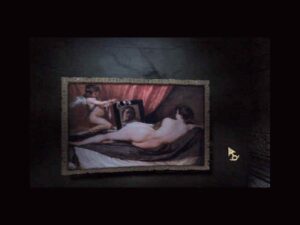
Venus dispenses hints if you click on her. What is the ancient Roman goddess of love, as painted by the seventeenth-century Spanish master Diego Velázquez, doing in the world of Zork? Your guess is as good as mine. Count it as just one more way in which this Zork can scarcely be bothered to try to be a Zork at all.
Released on the same day in April of 1996 as Spycraft, Activision’s other big test of the Siliwood vision’s ongoing viability, Zork Nemesis was greeted with mixed reviews. This was not surprising for a Myst clone, a sub-genre that the hardcore-gaming press never warmed to. Still, some of the naysayers waxed unusually vitriolic upon seeing such a beloved gaming icon as Zork sullied with the odor of the hated Myst. The normally reliable and always entertaining Charles Ardai of Computer Gaming World, the print journal of record for the hobby, whose reviews could still make or break a game as a marketplace proposition even in this dawning Internet age, dinged Zork Nemesis for not having much of anything to do with Infocom’s Zork, which was fair. Yet then he went on to characterize it as a creatively bankrupt, mindless multimedia cash-in, which was not: “Give ’em a gorgeous photo-realistic environment full of fantastic landscapes, some quasi-liturgical groaning on the soundtrack, and a simple puzzle every so often to keep their brains engaged, and you’re off to the bank to count your riches. Throw in some ghostly visions and a hint of the horrific and you can snag the 7th Guest crowd too.” One can only assume from this that Ardai never even bothered to try to play the game, but simply hated it on principle. I maintain that no one who has done so could possibly describe Zork Nemesis‘s puzzles as “simple,” no matter how much smarter than I am he might happen to be.
Even in the face of headwinds like these, Zork Nemesis still sold considerably better than the more positively reviewed Spycraft, seemingly demonstrating that Bobby Kotick’s faith in “Zork on a brick” might not yet be completely misplaced. Its lifetime sales probably ended up in the neighborhood of 150,000 to 200,000 copies — not a blockbuster hit by any means, and certainly a good deal less than the numbers put up by Return to Zork, but still more than the vast majority of Myst clones, enough for it to earn back the money it had cost to make plus a little extra.[2]In my last article, about Cyan’s Riven, I first wrote that Zork Nemesis sold 450,000 copies. This figure was not accurate; I was misreading one of my sources. My bad, as I think the kids are still saying these days. I’ve already made the necessary correction there. Whereas there would be no more interactive spy movies forthcoming from Activision, Zork Nemesis did just well enough that Kotick could see grounds for funding another Zork game, as long as it was made on a slightly less lavish budget, taking advantage of the engine that had been created for Nemesis. And I’m very glad he could, because the Zork game that resulted is a real gem.
With Cecilia Barajas having elected to move on to other things, Laird Malamed stepped up into her role for the next game. He was much more than just “familiar” with Zork. He had gotten a copy of the original Personal Software “barbarian Zork“ — so named because of its hilariously inappropriate cover art — soon after his parents bought him his first Apple II as a kid, and had grown up with Infocom thereafter. Years later, when he had already embarked on a career as a sound designer in Hollywood, a chance meeting with Return to Zork put Activision on his radar. He applied and was hired there, giving up one promising career for another.
He soon became known both inside and outside of Activision as the keeper of the Infocom flame, the only person in the company’s senior ranks who saw that storied legacy as more than just something to be exploited commercially. While still in the early stages of making Activision’s third graphical Zork, he put together as a replacement for the old Lost Treasures of Infocom collections a new one called Classic Text Adventure Masterpieces: 33 of the canonical 35 games on a single CD, with all of their associated documentation in digital format. (The Hitchhiker’s Guide to the Galaxy and Shogun, Infocom’s only two licensed titles, were the only games missing, in both cases because their licensing contracts had expired). He did this more because he simply felt these games ought to be available than because he expected the collection to make a lot of money for his employer. In the same spirit, he reached out to the amateur interactive fiction community that was still authoring text adventures in the Infocom mold, and arranged to include the top six finishers from the recently concluded First Interactive Fiction Competition on the same disc. He searched through Activision’s storage rooms to find a backup of the old DEC mainframe Infocom had used to create its games. This he shared with Graham Nelson and a few other amateur-IF luminaries, whilst selecting a handful of interesting, entertaining, and non-embarrassing internal emails to include on the Masterpieces disc as well.[3]This “Infocom hard drive” eventually escaped the privileged hands into which it was entrusted, going on to cause some minor scandals and considerable interpersonal angst; suffice to say that not all of its contents were non-embarrassing. I have never had it in my possession. No, really, I haven’t. It’s been rendered somewhat moot in recent years anyway by the stellar work Jason Scott has done collecting primary sources for the Infocom story at archive.org. No one at Activision had ever engaged with the company’s Infocom inheritance in such an agenda-less, genuine way before him; nor would anyone do so after him.
He brought to the new graphical Zork game a story idea that had a surprisingly high-brow inspiration: the “Grand Inquisitor” tale-within-a-tale in Fyodor Dostoevsky’s 1880 novel The Brothers Karamazov, an excerpt which stands so well on its own that it’s occasionally been published that way. I can enthusiastically recommend reading it, whether you tackle the rest of the novel or not. (Laird admitted to me when we talked that he himself hadn’t yet managed to finish the entire book when he decided to use a small part of it as the inspiration for his game.) Dostoevsky’s Grand Inquisitor is a leading figure of the Spanish Inquisition, who harangues a returned Jesus Christ for his pacifism, his humility, and his purportedly naïve rejection of necessary hierarchies of power. It is, in other words, an exercise in contrast, setting the religion of peace and love that was preached by Jesus up against what it became in the hands of the Medieval Catholic popes and other staunch insitutionalists.
For its part, Zork: Grand Inquisitor doesn’t venture into quite such politically fraught territory as this. Its titular character is an ideological rather than religious tinpot dictator, of the sort all too prevalent in the 20th and 21st centuries on our world. He has taken over the town of Port Foozle, where he has banned all magic and closed all access to the Great Underground Empire that lies just beneath the town. You play a humble traveling salesperson who comes into possession of a magic lantern — a piece of highly illegal contraband in itself — that contains the imprisoned spirit of Dalboz of Gurth, the rightful Dungeon Master of the Empire. He encourages and helps you to make your way into his forbidden realm, to become a literal underground resistance fighter against the Grand Inquisitor.
The preceding paragraphs may have led you to think that Zork: Grand Inquisitor is another portentous, serious game. If so, rest assured that it isn’t. Not at all. Its tone and feel could hardly be more different from those of Zork Nemesis. Although there are some heavy themes lurking in the background, they’re played almost entirely for laughs in the foreground. This strikes me as no bad approach. There are, after all, few more devastating antidotes to the totalitarian absurdities of those who would dictate to others what sort of lives they should lead and what they should believe in than a dose of good old full-throated laughter. As Hannah Arendt understood, the Grand Inquisitors among us are defined by the qualities they are missing rather than any that they possess: qualities like empathy, conscience, and moral intelligence. We should not hesitate to mock them for being the sad, insecure, incompletely realized creatures they are.
Just as I once suspected that Zork Nemesis didn’t start out as a Zork game at all, I was tempted to assume that this latest whipsaw shift in atmosphere for Zork at Activision came as a direct response to the vocal criticisms of the aforementioned game’s lack of Zorkiness. Alas, Laird Malamed disabused me of that clever notion as well. Grand Inquisitor was, he told me, simply the Zork that he wanted to make, initiated well before the critics’ and fans’ verdicts on the last game started to pour in in earnest. He told me that he practically “begged” Margaret Stohl, who has since gone on to become a popular fantasy novelist in addition to continuing to work in games, to come aboard as lead designer and writer and help him to put his broad ideas into a more concrete form, for he knew that she possessed exactly the comedic sensibility he was going for.
Regardless of the original reason for the shift in tone, Laird and his team didn’t hesitate to describe Grand Inquisitor later in its development cycle as a premeditated response to the backlash about Nemesis’s Zork bona fides, or rather its lack thereof. This time, they told magazines like Computer Gaming World, they were determined to “let Zork be Zorky”: “to embrace what was wonderful about the old text adventures, a fantasy world with an undercurrent of humor.”
Certainly Grand Inquisitor doesn’t lack for the concrete Zorkian tropes that were also all over Return to Zork. From the white house in the forest to Flood Control Dam #3 to Dalboz’s magic lantern itself, the gang’s all here. But all of these disparate homages are integrated into a larger Zorkian tapestry in a way Activision never managed elsewhere. Return to Zork is a compromised if not cynical piece of work, its slapstick tone the result of a group of creators who saw Zork principally as a grab bag of tropes to be thrown at the wall one after another. And Nemesis, of course, has little to do with Zork at all. But Grand Inquisitor walks like a Zork, talks like a Zork, and is smart amidst its silliness in the same way as a Zork of yore. In accordance with its heritage, it’s an unabashedly self-referential game, well aware of the clichés and limitations of its genre and happy to poke fun at them. For example, the Dungeon Master here dubs you the “AFGNCAAP”: the “Ageless, Faceless, Gender-Neutral, Culturally Ambiguous Adventure Person,” making light of a longstanding debate, ancient even at the time of Grand Inquisitor’s release, over whether it must be you the player in the game or whether it’s acceptable to ask you to take control of a separate, strongly characterized protagonist.
It’s plain from first to last that this game was helmed by someone who knew Zork intimately and loved it dearly. And yet the game is never gawky in that obsessive fannish way that can be so painful to witness; it’s never so much in thrall to its inspiration that it forgets to be its own thing. This game is comfortable in its own skin, and can be enjoyed whether you’ve been steeped in the lore of Zork for decades or are coming to it completely cold. This is the way you do fan service right, folks.
Although it uses an engine made for a Myst-like game, Grand Inquisitor plays nothing like Myst. This game is no exercise in contemplative, lonely puzzle-solving; its world is alive. As you wander about, Dungeon Master Dalboz chirps up from his lantern constantly with banter, background, and subtle hints. He becomes your friend in adventure, keeping you from ever feeling too alone. In time, other disembodied spirits join you as well, until you’re wandering around with a veritable Greek chorus burbling away behind you. The voice acting is uniformly superb.
Another prominent recurring character is Antharia Jack, a poor man’s Indiana Jones who’s played onscreen as well as over the speakers by Dirk Benedict, a fellow very familiar with being a stand-in for Harrison Ford in his most iconic roles, having also played the Han Solo-wannabee Starbuck in the delightfully cheesy old television Star Wars cash-in Battlestar Galactica. Benedict, one of those actors who’s capable of portraying exactly one character but who does it pretty darn well, went on to star in The A-Team after his tenure as an outer-space fighter jockey was over. His smirking, skirt-chasing persona was thus imprinted deeply on the memories of many of the twenty-somethings whom Activision hoped to tempt into buying Grand Inquisitor. This sort of stunt-casting of actors a bit past their pop-culture prime was commonplace in productions like these, but here at least it’s hard to fault the results. Benedict leans into Antharia Jack with all of his usual gusto. You can’t help but like the guy.
When it comes to its puzzles, Grand Inquisitor’s guiding ethic is to cut its poor, long-suffering AFGNCAAP a break. All of the puzzles here are well-clued and logical within the context of a Zorkian world, the sort of puzzles that are likely to stump you only just long enough to make you feel satisfyingly smart after you solve them. There’s a nice variety to them, with plenty of the “use object X on thing Y” variety to go along with some relatively un-taxing set-piece exercises in pushing buttons or pulling levers just right. But best of all are the puzzles that you solve by magic.
Being such a dedicated Infocom aficionado, Laird Malamed remembered something that most of his colleagues probably never knew at all: that the canon of Infocom Zork games encompassed more than just the ones that had that name on their boxes, that there was also a magic-oriented Enchanter trilogy which took place in the same universe. At the center of those games was one of the most brilliant puzzle mechanics Infocom ever invented, a system of magic that had you hunting down spell scrolls to copy into your spell book, after which they were yours to cast whenever you wished. This being Infocom, however, they were never your standard-issue Dungeons & Dragons Fireball spells, but rather ones that did weirdly specific, esoteric things, often to the point that it was hard to know what they were really good for — until, that is, you finally stumbled over that one nail for which they were the perfect hammer. Grand Inquisitor imports this mechanic wholesale. Here as well, you’re forever trying to figure out how to get your hands on that spell scroll that’s beckoning to you teasingly from the top of a tree or wherever, and then, once you’ve secured it, trying to figure out where it can actually do something useful for you. This latter is no trivial exercise when you’re stuck with spells like IGRAM (“turn purple things invisible”) and KENDALL (“simplify instructions”). Naturally, much of the fun comes from casting the spells on all kinds of random stuff, just to see what happens. Following yet again in the footsteps of Infocom, Laird’s team at Activision implemented an impressive number of such interactions, useless though they are for any purpose other than keeping the AFGNCAAP amused.
Grand Inquisitor isn’t an especially long game on any terms, and the fairly straightforward puzzles mean you’ll sail through what content there is much more quickly than you might through a game like Nemesis. All in all, it will probably give you no more than three or four evenings’ entertainment. Laird Malamed confessed to me that a significant chunk of the original design document had to be cut in the end in order to deliver the game on-time and on-budget; this was a somewhat marginal project from the get-go, not one to which Activision’s bean counters were ever going to give a lot of slack. Yet even this painful but necessary surgery was done unusually well. Knowing from the beginning that the scalpel might have to come out before all was said and done, the design team consciously used a “modular” approach, from which content could be subtracted (or added, if they should prove to be so fortunate) without undermining the structural integrity, if you will, of the game as a whole. As a result of their forethought, Grand Inquisitor doesn’t feel like a game that’s been gutted. It rather feels very complete just as it is. Back in the day, when Activision was trying to sell it for $40 or $50, its brevity was nevertheless a serious disadvantage. Today, when you can pick it up in a downloadable version for just a few bucks, it’s far less of a problem. As the old showbiz rule says, better to leave ’em wanting more than wishing you’d just get off the stage already.
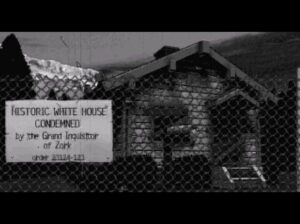
“You are standing in an open field west of a white house, with a boarded front door.” Unfortunately, the property has been condemned by the Grand Inquisitor. “Who is the boss of you? Me! I am the boss of you!”
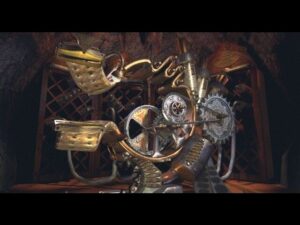
The “spellchecker” is a good example of Grand Inquisitor’s silly but clever humor, which always has time for puns. The machine’s purpose is, as you might have guessed, to validate spell scrolls.
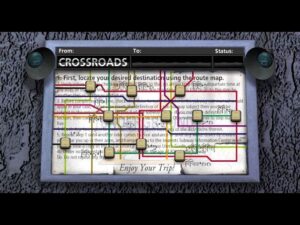
This subway map looks… complicated. Wouldn’t it be nice if there was a way to simplify it in a burst of magic? Laird told me that this puzzle was inspired by recollections of trying to make sense of a map of the London Underground as a befuddled tourist.
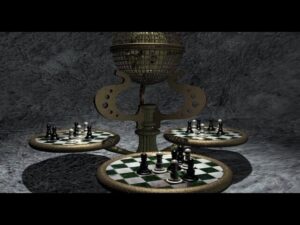
Nothing sums up the differences between Zork Nemesis and Zork: Grand Inquisitor quite so perfectly as the latter’s chess puzzle. In Nemesis, you’d be futzing around with this thing forever. And in Grand Inquisitor? As Scorpia wrote in her review for Computer Gaming World, “Think of what you’ve [always] felt like doing with an adventure-game chess puzzle, and act accordingly.”
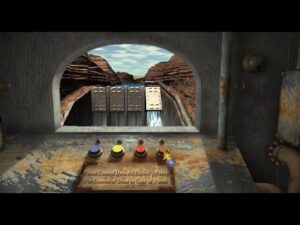
There are some set-piece puzzles that can’t be dispatched quite so easily. An instruction booklet tells you to never, ever close all four sluices of Flood Control Dam Number 3 at once. So what do you try to do?
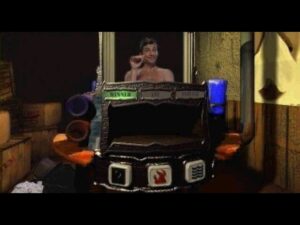
Playing Strip Grue, Fire, Water with Antharia Jack. The cigars were no mere affectation of Dirk Benedict. His costars complained repeatedly about the cloud of odoriferous smoke in which he was constantly enveloped. A true blue Hollywood eccentric of the old-school stripe, Benedict remains convinced to this day that the key to longevity is tobacco combined with a macrobiotic diet. Ah, well… given that he’s reached 79 years of age and counting as of this writing, it seems to be working out for him so far.
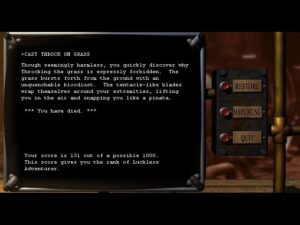
Be careful throwing around them spells, kid! Deaths in Grand Inquisitor are rendered in text. Not only is this a nice nostalgic homage to the game’s roots, it helped to maximize the limited budget by avoiding the expense of portraying all those death scenes in graphics.
Laird Malamed had no sense during the making of Grand Inquisitor that this game would mark the end of Zork’s long run. On the contrary, he had plans to turn it into the first game of a new trilogy, the beginning of a whole new era for the venerable franchise. In keeping with his determination to bring Zork back to the grass roots who knew and loved it best, he came up with an inspired guerrilla-marketing scheme. He convinced the former Infocom Implementors Marc Blank and Mike Berlyn to write up a short text-adventure prelude to the story told in Grand Inquisitor proper. Then he got Kevin Wilson, the organizer of the same Interactive Fiction Competition whose games had featured on the Masterpieces CD, to program their design in Inform, a language that compiled to the Z-Machine, Infocom’s old virtual machine, for which interpreters had long been available on countless computing platforms, both current and archaic. Activision released the end result for free on the Internet in the summer of 1997, as both a teaser for the graphical game that was to come and a proof that Zork was re-embracing its roots. Zork: The Undiscovered Underground isn’t a major statement by any means, but it stands today, as it did then, as a funny, nostalgic final glance back to the days when Zork was nothing but words on a screen.
Unfortunately, all of Laird’s plans for Zork’s broader future went up in smoke when Grand Inquisitor was released in November of 1997 and put up sales numbers well short of those delivered by Nemesis, despite reviews that were almost universally glowing this time around. Those Infocom fans who played it mostly adored it for finally delivering on the promise of its name, even if it was a bit short. The problem was that that demographic was now moving into the busiest phase of life, when careers and children tend to fill all of the hours available and then some. There just weren’t enough of those people still buying games to deliver the sales that a mass-market-focused publisher like Activision demanded, even as the Zork name meant nothing whatsoever to the newer generation of gamers who had cut their teeth on DOOM and Warcraft. Perhaps Bobby Kotick should have just written “Zork” on a brick after all, for Grand Inquisitor didn’t sell even 100,000 units.
And so, twenty years after a group of MIT graduate students had gotten together to create a game that was even better than Will Crowther and Don Woods’s Adventure, Zork’s run came to an end, taking with it any remaining dregs of faith at Activision in the Siliwood vision. Apart from one misconceived and blessedly quickly abandoned effort to revive the franchise as a low-budget MMORPG during the period when those things were sprouting like weeds, no Zork game has appeared since. We can feel sad about this if we must, but the reality is that nothing lasts forever. Far better, it seems to me, for Zork to go out with Grand Inquisitor, one of the highest of all its highs, than to be recycled again and again on a scale of diminishing returns, as has happened to some other classic gaming franchises. Likewise, I’m kind of happy that no one who made Grand Inquisitor knew they were making the very last Zork adventure. Their ignorance caused them to just let Zork be Zork, meant they were never even tempted to turn their game into some over-baked Final Statement.
In games as in life, it’s always better to celebrate what we have than to lament what might have been. With that in mind, then, let me warmly recommend Zork: Grand Inquisitor to any fans of adventure games among you readers who have managed not to play it yet. It really doesn’t matter whether you know the rest of Zork or not; it stands just fine on its own. And that too is the way it ought to be.
Did you enjoy this article? If so, please think about pitching in to help me make many more like it. You can pledge any amount you like.
Sources: the books Zork Nemesis: The Official Strategy Guide by Peter Spear and Zork: Grand Inquisitor: The Official Strategy Guide by Margaret Stohl; Computer Gaming World of August 1996, February 1997, and March 1998; InterActivity of May 1996; Next Generation of August 1997; Los Angeles Times of November 30 1996.
Online sources include a 1996 New Media profile of Activision and “The Trance Experience of Zork Nemesis“ at Animation World.
My thanks to Laird Malamed for taking the time from his busy schedule to talk to me about his history with Zork. Note that any opinions expressed in this article that are not explicitly attributed to him are my own.
Zork Nemesis and Zork: Grand Inquisitor are both available as digital purchases at GOG.com.
Footnotes
| ↑1 | The CD-ROM version included fourteen games, missing only Leather Goddesses of Phobos, which Activision attempted to market separately on the theory that sex sells itself. The floppy version included eleven games, lacking additionally three of Infocom’s late illustrated text adventures. |
|---|---|
| ↑2 | In my last article, about Cyan’s Riven, I first wrote that Zork Nemesis sold 450,000 copies. This figure was not accurate; I was misreading one of my sources. My bad, as I think the kids are still saying these days. I’ve already made the necessary correction there. |
| ↑3 | This “Infocom hard drive” eventually escaped the privileged hands into which it was entrusted, going on to cause some minor scandals and considerable interpersonal angst; suffice to say that not all of its contents were non-embarrassing. I have never had it in my possession. No, really, I haven’t. It’s been rendered somewhat moot in recent years anyway by the stellar work Jason Scott has done collecting primary sources for the Infocom story at archive.org. |
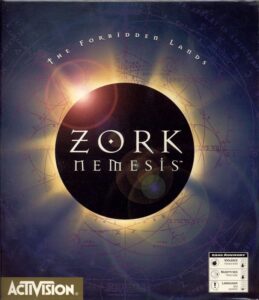
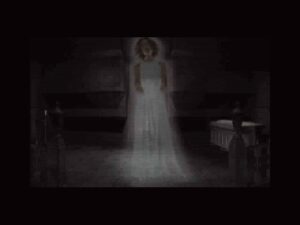
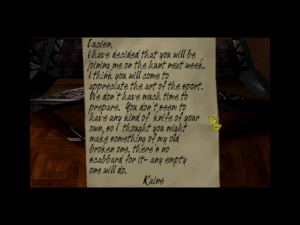
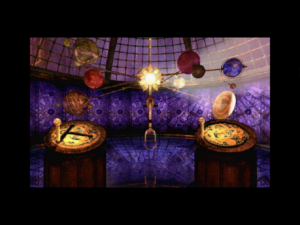
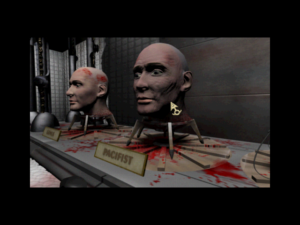
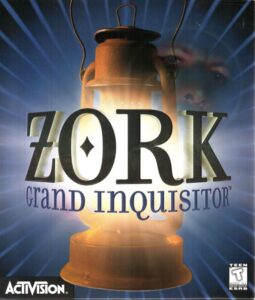











Andrew Plotkin
June 7, 2024 at 5:05 pm
Thanks; this was a great way to remember the end of the (commercial) Zork era. It was an exciting time for me — I’d done well in the first IFComp and so wound up on that Masterpieces CD. A heady boost for a 26-year-old aspiring game designer! I even scored a final-candidate build of ZGI for Mac, a year and a half before Activision got that port onto store shelves.
I never realized that the “Infocom hard drive” had been dug out by Laird Malamed originally. I suppose it was the obvious route, but by the time I heard about it, the provenance was in the realm of (scurrilous) rumor.
> I developed the working theory as I played Zork Nemesis that it must have been originally conceived as simply a Myst-like adventure game
Heh. I had exactly the same theory, and got exactly the same reply from Laird.
Anyhow, I still remember ZN fondly. ZGI didn’t leave that much impression (though more than RTZ did!). According to my notes I found it reliably funny and mostly well-designed. Good job.
> (The Hitchhiker’s Guide to the Galaxy and Shogun, Infocom’s only two licensed titles, were the only games missing, in both cases because their licensing contracts had expired).
Do you have a source on this? The expired contracts, I mean. I’ve always *believed* that was the case — the timing lines up neatly. (The LTOI collection, which included Hitchhiker, was released seven years after the original Hitchhiker release. The Masterpieces CD, which did not, was five years after that. So a ten-year contract?)
But I’ve never actually *seen* such a contract, or heard anybody on the inside confirm this. Is this info from Laird Malamed?
Jimmy Maher
June 7, 2024 at 7:55 pm
I’ve never seen the contracts, so there’s some surmising going on here. I know more of the details of the contract with Douglas Adams, which was to have allowed Infocom to make six (!) Hitchhiker’s games, with or without his input. (It was only Infocom’s sense of fair play that prevented them from going off and making games on their own when he kept procrastinating…) Even here, I’ve never seen an expiration date explicitly printed or stated, however.
But the circumstantial evidence is pretty strong, I think, especially when it comes to Hitchhiker’s. Ten years would indeed be a reasonable term for a contract like the one with Douglas Adams, and would have it expiring neatly between Lost Treasures (which included Hitchhiker’s) and Masterpieces (which did not). Then, too, it seems really odd to leave Hitchhiker’s out of the the Masterpieces collection if not absolutely forced to, give that it was Infocom’s second best-selling and second best-remembered game of them all.
Shogun makes a little bit less compelling of a case on the face of it, since it was first released in 1988. A ten-year contract here would still have had a couple of years to go in 1996. Then again, if Activision (or at least Laird) saw Masterpieces as a potentially long-term catalog product, they may have wanted to avoid the complications of having to take Shogun out at some point. And of course, unlike Hitchhiker’s, it wasn’t a particularly well-loved or well-known game.
My perceptions of all of this are colored by my awareness of the complications of licensing deals in general. Even now, when most games that are still remembered at all are available to buy at GOG.com and/or Steam, it’s the licensed titles that tend to be the exceptions. The contracts always have an expiration date and usually aren’t considered worth renegotiating by either or both parties, in light of the low ceiling on possible sales of such old games.
I would indeed have liked to have asked Laird about this, but he’s got a fairly high-profile gig at Meta and is a busy guy these days. He could only give me an hour. Suddenly his computer was beeping at him to join the next meeting and we had to stop.
On the subject of the Infocom backup drive, though, Laird did tell me himself that he was the one who found it and shared it with a select few.
Andrew Plotkin
June 7, 2024 at 8:47 pm
Thanks. I guess we’ll leave the licensing terms in the “probably” column.
I agree that the circumstantial evidence is strong. The other clue is that around 1996 or 1997, Douglas Adams put the game up on his *own* web site, using an open-source Z-machine interpreter (a Java applet, if I recall). So he had the rights back, or at least had some confidence that Activision wouldn’t object.
I’ve always imagined the estate of James Clavell getting back the rights to the Shogun game… and then going to find a shovel to see how deep they could bury it in the back garden.
Jimmy Maher
June 14, 2024 at 6:29 am
From the horse’s (or rather Laird’s) mouth, via email:
“You are 100% right that licensing was the reason HHGTTG and Shogun were not included. The contracts for both had expired. We probably could have included Shogun and no one would have noticed. But for sure the fans would have celebrated Hitchhikers and made noise. Not that we would have risked it anyway.”
Mateus Fedozzi
June 7, 2024 at 5:43 pm
It’s always a treat reading your articles about Infocom and what became of its legacy. Also, reading what a fan has to say about their favorite company always warms my heart, and you cannot hide you’re the number one Infocom fan alive (or will you lie to us and say you didn’t start Digital Antiquarian to tell Infocom’s and IF’s histories in detail?). Great article!
Andrew Pam
June 7, 2024 at 6:27 pm
“This he shared this with Graham Nelson” – typo, remove one “this”.
Jimmy Maher
June 7, 2024 at 8:05 pm
Thanks!
Dan V.
June 7, 2024 at 7:05 pm
Zork: Nemesis was my re-engagement with the series as a teen, having long given up on the text versions when I tried them on the Commodore. During the time when Myst was taking computer labs by storm it stuck out a bit as an odd duck. This puts it all into context, especially having come back to the text adventures when I was in college. But then again I was used to entries in a series having wildly different interpretations.
A minor suggestion…
“His smirking, cigar-chomping persona was thus a beloved childhood totem for many of the twenty-somethings whom Activision hoped to tempt into buying Grand Inquisitor.”
George Peppard’s Hannibal Smith was the cigar-chomper of the A-Team crew (or at least, I associate him with it the most). Perhaps “His smirking, Corvette-driving persona” is more appropriate for Dirk Benedict’s Templeton Peck, AKA Face Man?
JeroenJ
June 7, 2024 at 8:06 pm
Dirk Benedict also played Starbuck in the original Battlestar Galactica TV-series, and that character was fond of smoking cigars also.
Jimmy Maher
June 7, 2024 at 8:11 pm
I remember him mainly from Battlestar Galactica. I only occasionally watched The A-Team. Thanks!
Dan V.
June 10, 2024 at 2:10 pm
Good point about Starbuck; he was definitely a smoker in Battlestar. I bet this is one of those generational things—I wasn’t around for the OG Battlestar, but I was raised on a healthy diet of A-Team. The new edit definitely applies to both characters.
JeroenJ
June 7, 2024 at 8:03 pm
Great, I was looking forward to this one!
Zork Nemesis has been one of my favourite games for a long time (I think I played it through three or four times). Grand Inquisitor didn’t resonate with me all that much, perhaps because not being from the US I wasn’t familiar with most of the actors in the cameos — which may have left me a bit indifferent for that reason (but I did know Dirk Benedict of course).
Lee Hauser
June 8, 2024 at 3:31 am
Nice article. A wee typo: “who were howling at his door at bay for a whee bit longer” should be “a *wee* bit”.
Jimmy Maher
June 8, 2024 at 7:58 am
Thanks!
Jason Dyer
June 8, 2024 at 4:56 am
I thought only the top three from each category (TADS and Inform) made it on the Masterpieces disc.
I still have my contract from back then if you want a scanned copy.
Jimmy Maher
June 8, 2024 at 8:00 am
That does ring a bell, now that you say it. Thanks!
arcanetrivia
June 8, 2024 at 7:06 am
who had been pushing for the bankrupt company to be liquefied rather than reorganized.
This is a gruesomely hilarious image, but I think you meant “liquidated”.
My main recollection of Nemesis is that it was horrific and gruesome in a way none of the other games were. Not just the sense of exploring an empty place that was abandoned ages ago (maybe with one or two other wanderers like yourself), which can fit right in with the textual Zorks, but like… why are there cut up body parts? sort of horror. Completely lacking that other thread of smartass humor that otherwise characterized the Zork and Enchanter games, even Return to Zork (for all its other faults).
Grand Inquisitor, on the other hand, I’d recommend to anyone who likes adventure games. As you note, it was definitely made with love.
Jimmy Maher
June 8, 2024 at 8:02 am
:) Thanks!
gamer indreams
June 15, 2024 at 8:44 pm
No thank you Jimmy for giving us that mental image of moribund companies being frog in a blender-ed!
Sean C Curtin
June 8, 2024 at 7:33 am
I always did find it an ironic coincidence that Zork and Wizardry, two series that were iconic representatives of their respective genres in the ’80s, both dropped games in 1996 that fully broke tradition with said genres under the subtitle “Nemesis.”
Ah, Nemesis: The Wizardry Adventure, a failed experiment doomed to be utterly forgotten outside of comprehensive Wizardry franchise retrospectives. Whatever else one might have to say about Zork Nemesis, it’s at least distinctive even among the crowded field of contemporaneous Myst-em-ups.
Miron Schmidt
June 8, 2024 at 11:40 am
A great read as usual, especially since you made some connections that hadn’t been made before, to my knowledge.
Just one small correction, though: The Lost Treasures of Infocom II didn’t include the missing fifteen games, but only 11.5. From the Infocom Fact Sheet: “This one contained only 11 games; “Journey”, “Shogun”, “Arthur” and “Leather Goddesses of Phobos” were not included (but the package contained a special $9.95 priced offer for LGOP).”
Anyway, thanks for your work as always! I refer to your site on a regular basis when researching something as I know that these errors are few and far between.
Jimmy Maher
June 8, 2024 at 12:50 pm
The CD-ROM version actually contained fourteen games, missing only Leather Goddesses of Phobos. The floppy version had eleven. I’ve added a footnote. Thanks!
Leo Vellés
June 8, 2024 at 5:51 pm
“As Hannah Arendt understood, the Grand Inquisitors among us are defined by the qualities they are missing rather than any that they possess: qualities like empathy, conscience, and moral intelligence. We should not hesitate to mock them for being the sad, insecure, incompletely realized creatures they are”.
Wow Jimmy, you just described the actual president (sadly) of my country, Argentina
Eric Nyman
June 8, 2024 at 8:47 pm
“Describes a lot of politicians in our country these days, too,” replied the American, feeling nostalgic for the Before Times (pre-2015).
Leo Vellés
June 8, 2024 at 9:09 pm
Yeah, but google Javier Milei. The other day he said he has come “from an apocalyptic future, like Terminator”, and he runs the destiny of my country. :(
arthurdawg
June 10, 2024 at 10:51 am
No kidding… I can only hope the recent elections in India presage a dramatic rollback of the authoritarian wave that has buffeted the shores of our world over the past decade.
Eric Nyman
June 8, 2024 at 8:53 pm
A couple quick notes and additions to your usual extremely well researched and well written entry–
Grues do exist in Zork Nemesis. In a crypt in the monastery it is possible to hear them gurgling in the dark, and get eaten if you don’t bring a torch with you. I also think there is a book that shows them in their natural habitat with a blank black page (or was that in Grand Inquisitor)?
I wonder if James Clavell’s death in 1994 affected the status of Infocom/Activision’s rights to Shogun (Andrew may have been alluding to this by referring to Clavell’s estate, above).
Jimmy Maher
June 8, 2024 at 9:04 pm
Thanks!
I do doubt that Clavell’s death was a factor. These things are the very ones that an estate consists of…
Eric Nyman
June 8, 2024 at 10:33 pm
Edit: after some research, I found that there is indeed a book in the library in Nemesis entitled “Interview With a Grue” that has the picture I mentioned.
Such humorous references to the Infocom of yore definitely felt dissonant within the game’s macabre atmosphere, however.
Fair point about Clavell. I just happened to remember his death as an event that otherwise aligned chronologically with the loss of Shogun from Infocom compilations.
Todd
June 8, 2024 at 9:34 pm
“(Not that you’ll find any grues in this least Zorky of all Zork games.)”
There is a book with a completely black picture captioned “The grue in its natural habitat” — one of only a few attempts at Zork-style humor in Zork Nemesis that landed for me.
(I think the monastery also has a dark tunnel where you will be eaten by a grue if you don’t bring a light source, but Imcould be remembering that wrong.)
Marco
June 8, 2024 at 10:08 pm
Thanks indeed for this article. While most of these 90s adventure games I only came to many years later, ZGI and then a budget reissue of Nemesis were the two I bought at the time. I played the demo for ZGI from a magazine that had a review and the enticing “You’ll always remember your first time Underground” adverts. We had little money in 1997 so ZGI was a special Christmas present; every day leading up I was anxious my mother wouldn’t have bought it and all copies would have vanished from our branch of HMV. It’s a game that means something in my life.
Return to Zork: truly is an evil game, my soft spot for AJ Langer being the one thing in its favour.
Nemesis: I really like, even though I could have done without a couple of the most gruesome moments. It’s a good length, and for me the puzzles were just right – challenging, and in most cases plausible for the setting and plot, but actually doable without resorting to a walkthrough. The difficulty of making good puzzles, rather than resorting to illogical combinations of items or dusting off the same few old chestnuts (like fox-chicken-grain), has in my view always been the biggest problem with adventure games, so the success of Nemesis in this department really shouldn’t be underestimated. The machines to create each alchemical metal are my particular favourites. I do push back on the oft-repeated claim that Nemesis has no humour – it really does, it’s just subtle. (The New Zorker, the fuzzy dice in the tank, the touching note from the Brogmoid cleaner, the Easter egg if you play the records backwards, the note in the Monastery when you recover the coin are just a few that spring to mind, and I haven’t played it for years.) On the serious side, for some reason I have always found the Conservatory incredibly creepy – even though nothing bad happens, you always feel it’s just about to.
ZGI: I last played in 2021, when I was ill with Covid and had brain fog. It’s the ultimate comfort game to return to at a tough time. The integration of graphics, music and design concepts is just wonderful, bringing the Great Underground Empire fully to life. Dirk Benedict’s performance is good, though I particularly love Erick Avari’s chewing the scenery as the Grand Inquisitor. But… I think you are underplaying how much it was cut down from the original concept. Back at Christmas ‘97, I kept hoping the vistas would open up into a proper quest, but no – each time it was a couple of nodes and another big stride towards the finish. Nor do any of the puzzles slow you down – they all have easy or cheat solutions, and the one properly challenging one (letting Antharia Jack out of the right cell) is botched. I suspect if it had been realised as conceived, it would have been the best adventure game ever – as is, it’s still good but one can’t help wanting more.
Ross
June 10, 2024 at 12:18 pm
I’m not sure I’ve played ZGI since around ’99 or so, but I defintely remember my experience being that l liked all the stuff that was there, but it felt very small by the standards of a full commercial release of the period. If memory serves, it came on one disc around the time of peak “Prestigious releases come on a ridiculous pile of CDs”
(IIRC, my CD-ROM drive burned out while I was playing it, though, which may have colored my perception)
Marco
June 10, 2024 at 5:50 pm
I think there were two discs, but Nemesis had three and other peers had four or five. I completed ZGI in a week, even trying to pace myself and as a not genre-savvy 13 year old. It was particularly disappointing because the demo gave the impression these were the opening few rooms of an epic quest, but there wasn’t actually a whole lot more in the full game.
Compare that with, for example, Sherlock Holmes and the Case of the Rose Tattoo, which I came to later but gave me weeks and weeks of entertainment.
John
June 9, 2024 at 12:32 pm
Benedict’s costars were right to complain. I grew up with a cigar-smoking father. He smoked just a cigar a day on weekends, and he always did it outside, but everything in his house smelled like cigars anyway–including me if I wasn’t careful.
As for Zork, I’m glad it got to go out on a high note. I never played any of the Zork games myself. The closest I ever came was the Zork-adjacent Wishbringer, which I don’t think I ever actually finished. I think I may be just a tad too young to ever have gotten into strictly text adventures. The very first adventure game I ever played as a kid in the early 80s was a graphical one, a Robin Hood-themed game in something like the very early Sierra style.
Brett
June 10, 2024 at 5:23 pm
There were significant links to the Infocom days in Zork Nemesis. The diary that came with it, as well as some of the revealed backstory, drew from the old Zork gamebooks, for instance.
The biggest link, which isn’t clear in the game, is that “Nemesis” is supposed to be the Thief from Zork I, left in a disembodied state from being killed in that game. There was a text adventure prequel like the Undiscovered Underground that was to make this explicit, as you play the Thief/Nemesis just prior to that happening. It was never commercially published but I remember seeing the bits of it floating around the Internet years ago.
vykromond
June 11, 2024 at 7:51 pm
[nit] ” competing for plumb roles in games” – should be “plum roles”
Jimmy Maher
June 12, 2024 at 7:04 am
Thanks!
Peter
June 12, 2024 at 5:05 pm
Assuming that KENDALL is used to simplify the subway map, that must be a nod to MIT, since “Kendall/MIT” is MIT’s subway stop on the MBTA’s Red Line. (Maybe that’s obvious to Zork fans, but as a Zork foreigner I was able to pick up on that just from this article!)
Great as always, and thanks!
Marco
June 12, 2024 at 8:01 pm
Thanks, I hadn’t known about Kendall! (Though, going back to the earlier Zorks, I get the feeling the Frigid River and surroundings is inspired by the Hudson River Valley.)
Jason Scott
June 13, 2024 at 11:37 pm
I am very comfortable with the narrative that the Infocom Hard Drive came via Laird Malamed and encourage that to be the official canon.
gamer indreams
June 15, 2024 at 8:51 pm
Saying Laird Malamed’s a bigshot at Meta feels like really burying the lede. Not only did he head up development for Activision during COD, Guitar Hero, skylanders, etc but he’s also the founding COO/CFO for Oculus VR and even did sound editing for lucasfilm. He’s basically video gaming royalty
https://www.mobygames.com/person/20579/laird-m-malamed/credits/
People who love Zork, infocom and interactive fiction that much deserve to do well and he seems to have done!
Graeme Cree
June 27, 2024 at 5:11 pm
People who thought that Zork Nemesis wasn’t Zork probably hadn’t played anything except Return to Zork and Zork Zero.
It’s those comedy games that are the atypical ones. Zork Nemesis is much closer to the feel of the original Zork Trilogy than those later games. I’d defy anybody to find a laugh in Zork III. Maybe a smile or two, at best. Zork I and II are a lot like Zork Nemesis. They’re basically straightforward, even dark games, that have odd, and seemingly out of place comedy references sprinkled into them: Dimwit Flathead, turning a castle into fudge, Grues Day, and all the rest. It’s not until you’ve played it enough that you realize that the comedy references aren’t out of place, they’re the whole mood of Zork. The feeling that somewhere out there, someone is having (or had) a really good time, but it’s not here where you are. It’s just a bit like the feel of Back to the Future II.
The main difference between Zork Nemesis and the early Zorks isn’t the mood or feel, but the fact that Zork Nemesis is heavily dependent on story and characters, while the early Zorks really have no story, only a goal. I think I remember Marc Blank responding to the criticism that The Undiscovered Underground had no story, and he said yeah, that’s exactly what the early Zork games were like.
Darboz the Evoker
August 29, 2024 at 7:17 pm
100% agree, and I loved Zork Nemesis. *My* biggest gripe with it was how very brief the end sequence is. Over the years I’ve come to like a notion I came up with that that ending is very visually complex, and if described as text it would have been pages and pages – and therefore Nemesis has just as complete an ending as any other Infocom game, it only *seems* short. ;)
Graeme Cree
June 28, 2024 at 2:49 pm
BLOG: “Return to Zork is… the result of a group of creators who saw Zork principally as a grab bag of tropes to be thrown at the wall one after another.”
In their defense, that’s sort of what it is. Almost. There are no established characters or places that people expect to see in a Zork game. There is a history of sorts spread piecemeal over all the games, but nothing that everyone expects to hear about. Nobody’s even quite sure what Zork means. In Sorcerer, it says that Zork is the STORY of an ordinary schmoe who became a master of magic (which applies to the trilogy, but not most Zork-universe games). The novel “The Lost City of Zork” says it’s the name of the planet. There are probably other answers.
RTZ and ZGI both took us to a place that claimed to be Flood Control Dam #3. But in neither case was it located underground, where we saw it before. The Flood Control Dam #3 from Shadow Warrior was as Zorky as those two. The important thing was just to toss out the name for players to recognize. At least the White House in ZGI felt like it COULD have been the same one from Zork I.
Tossing out tropes is part of it, but what makes or breaks it is the tone. I mentioned in the last post why I thought Zork Nemesis did in fact feel a lot like the original Zork Trilogy, the way the comic references are found scattered through libraries and museums in otherwise non-comic situations. (They may have outsmarted themselves, with Bivotar, Syovar, and Ellron, which nobody who hadn’t read Steve Meretzky’s pick-a-path books would even recognize.)
If Zork Nemesis feels more like the original trilogy, then Grand Inquisitor feels more like Zork Zero. ZGI may have felt more Zorky than ZN because Zork Zero was more recent. But even then, what exactly did ZGI DO to recreate that Zorky feeling? They resurrected the magic system… not from one of the Zork-labeled games, but from *Enchanter*. It definitely works, but it shows how elastic the definition of “Zork” really is.
Marco
July 12, 2024 at 10:41 am
Late to this but fully agree, both on how fluid a concept Zork is – let’s face it, the most confusing thing of all is that Great Underground Empire is frequently used to refer to locations which aren’t underground – and on the Zork tone being a sudden drop of martini-dry humour into situations that are otherwise quite dark and unsettling.
Graeme Cree
April 11, 2025 at 4:00 pm
Zork Nemesis was great, but I was fuzzy on the timeline while playing it. When you go to the Alchemist’s homes, it looks like everybody has just stepped out for a bit. But other references indicate a much longer time. Sophia says something about repaying Lucien for an eternity of torment.
I think one of the timelines I checked indicated that the game began about three years after the day that Lucien, Alexandra and the Alehcmists all died. But in that time Ellron still hasn’t conquered Irondune, despite no general conducting the defense. The Conservatory seems only temporarily closed, like they’re still waiting for Sophia to return. The Monastery doesn’t seem totally out of business. Not sure about the hospital, but so many things about the times seem slightly off. A locket that Alexandria dropped into the boiler room years ago is still there.
The whole bit about why the Forbidden Lands are forbidden is also murky. The opening narration refers to an act being so evil that it can curse the world… Um, okay. So… the idea is that all the nearby pestilence is caused by the act that took place that day? Is it going to spread, or just stay where it is? Honestly, I could have done without this whole angle. Going to Agrippa to look for the Alchemists is a reasonable enough mission without needing all that other stuff.
Matt
July 27, 2024 at 6:14 pm
Fantastic article. It drive me to replay ZGI for the first time in over 25 years. What a game! The puzzles are deeply satisfying, the humour is good natured and doesn’t try too hard, the acting is pitched just right too. I think a special mention should be made of the music which is really effective in this game. It has little comedic stings that punctuate the cut scenes and atmospheric pieces that you don’t notice most of the time but are really effective.
Horkthane
August 7, 2024 at 7:12 pm
Zork Nemesis was my first Zork game, having been immersed in Computer Gaming World’s affection for the series for years, but being turned off by their text only format having been raised on Nintendo. I think I mostly purchased it because it was called Zork, and I remember some variety of Cnet Central show on Sci-Fi channel heavily promoted it one episode.
It was OK. I found the puzzles too difficult at that age, and very little about it made any sort of lasting impression on me. But I think I did enjoy it once I found help online, and was impressed by the cutscenes in 1996. Of course, using a walkthrough largely destroys the experience, which is probably why I remember so little of it today.
Zork Grand Inquisitor was a day one purchase for me, having gotten excited about it from previews in Computer Gaming World, and presumably having enjoying Nemesis, such as it was. Playing it was a breath of fresh air, as it felt like I was finally experiencing the Zork I always heard people reflect fondly on. The puzzles all made a lot more sense to me, although I remember being disappointed in how short the game was.
I did replay both rather recently. Funnily enough, I enjoyed Zork Nemesis a lot more due to it’s greater length and more difficult puzzles. Sadly, Zork Grand Inquisitor was just too ingrained in my memory. I still remembered all the jokes and all the puzzle solutions as if it was yesterday. Playing it again was a rather boring, rote experience. Although I do look forward to playing it with my daughter one day when she’s old enough, and experiencing it fresh through her eyes.
Darboz the Evoker
August 29, 2024 at 7:19 pm
Phil Spencer at Microsoft specifically mentioned wanting to do something with the Infocom IP when they acquired Activision. But as far as I can tell, since they did… crickets. Has anyone else heard anything promising at all?
Kevin Butler
September 24, 2024 at 5:39 pm
Very nice article as always. Just one thing I noticed:
“…Laird Malamed stepped up into her role for the next game. He was much…” Is Laird male or female. First part implies female while next sentence implies male.
Jimmy Maher
September 25, 2024 at 6:46 am
The “her” refers to Cecilia Barajas.
S
December 30, 2024 at 1:06 pm
As someone who did not witness that era personally, the part at the end, where you mention that the very first Zork was created only 20 years prior, gives me hefty time compression whiplash. The timespan you covered on this blog feels like an eternity, but is hardly longer then the time since say Oblivion or the PS3, which burned themselves in my brain as “next-gen” and not ancient at all.
Hell, some mainstream AAA-titles are approaching a development cycle about that long…
Jeff Vaughn
March 2, 2025 at 5:01 pm
I’ve been dying to integrate something funny between Bluetooth and GRUEs. “Gruetooth” should be a thing in the story. Mixing old with new would work as look as it’s got a little humor in the mix.A little modern tech couldn’t hurt. I love the look of the game, i just want something really immersive and that holds true to both the past and the present :)
nuff said?
Charles Ardai
May 22, 2025 at 1:15 am
What a wonderful essay (which for some reason I only just now stumbled across!). Any excuse to step back into the world of Infocom puts a big smile on my face, even after all these years. And you’re right to question my describing the puzzles in NEMESIS as “simple” — it’s been a lot of years, so who knows precisely what was going through my head when I wrote that, but I think it was something like “arbitrary puzzles rather than story-driven puzzles” — I’ve always loved story puzzles (like “where can I logically use a spell with this peculiar effect?”) more than “align these dials in the right pattern” or “pull these levers in the right sequence” puzzles. Something about the latter always felt like filler to me, a simple way to add gameplay time without adding meaningfully to the story. In fairness, if I replayed the game today, I might feel differently about it. But I can tell you that the small, free, three(?)-location UNDISCOVERED UNDERGROUND gave me much more pleasure (for all its brevity) than NEMESIS did.
EngineOfCreation
May 26, 2025 at 2:22 pm
>it was powered by 3D graphics that were rendered on the fly in real time.
More of a stylistic quibble: Do you see a substantial difference between “on the fly” and “in real time”, or was the doubling intentional?
Jimmy Maher
May 27, 2025 at 11:57 am
No, one or the other is definitely the way to go. ;) Thanks!